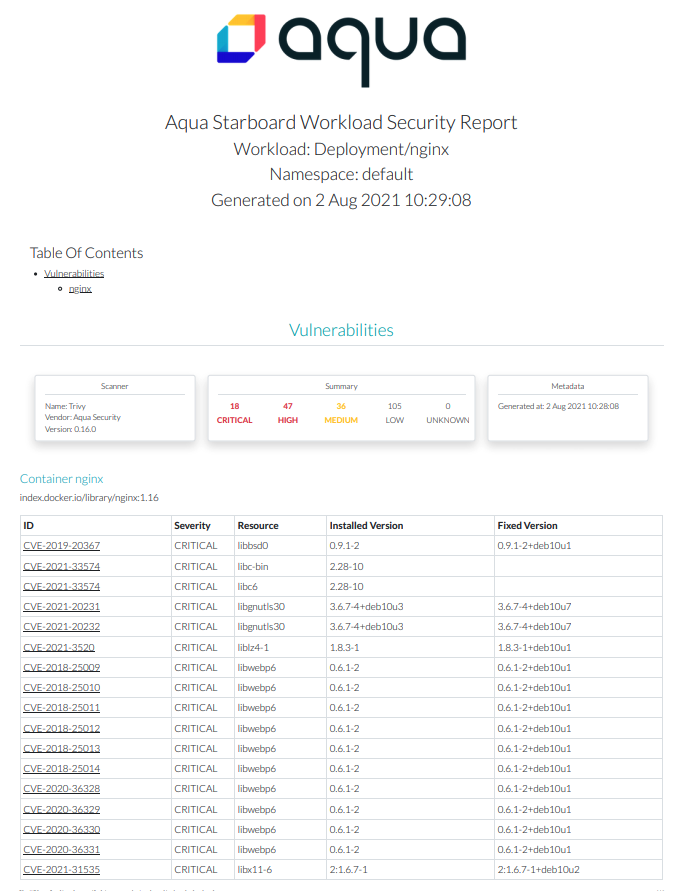Getting Started¶
Before you Begin¶
You need to have a Kubernetes cluster, and the kubectl command-line tool must be configured to communicate with your cluster. If you do not already have a cluster, you can create one by installing minikube or kind, or you can use one of these Kubernetes playgrounds:
You also need the starboard command to be installed, e.g. from the binary releases.
By default, it will use the same configuration as kubectl to communicate with the cluster.
Scanning Workloads¶
The easiest way to get started with Starboard is to use an imperative starboard command, which allows ad hoc scanning
of Kubernetes workloads deployed in your cluster.
To begin with, execute the following one-time setup command:
starboard init
The init subcommand creates the starboard namespace, in which Starboard executes Kubernetes jobs to perform
scans. It also sends custom security resources definitions to the Kubernetes API:
$ kubectl api-resources --api-group aquasecurity.github.io
NAME SHORTNAMES APIGROUP NAMESPACED KIND
ciskubebenchreports kubebench aquasecurity.github.io false CISKubeBenchReport
configauditreports configaudit aquasecurity.github.io true ConfigAuditReport
kubehunterreports kubehunter aquasecurity.github.io false KubeHunterReport
vulnerabilityreports vulns,vuln aquasecurity.github.io true VulnerabilityReport
Tip
There's also a starboard cleanup subcommand, which can be used to remove all resources created by Starboard.
As an example let's run in the current namespace an old version of nginx that we know has vulnerabilities:
kubectl create deployment nginx --image nginx:1.16
Run the vulnerability scanner to generate vulnerability reports:
starboard scan vulnerabilityreports deployment/nginx
Behind the scenes, by default this uses Trivy in Standalone mode to identify vulnerabilities in the container images associated with the specified deployment. Once this has been done, you can retrieve the latest vulnerability reports for this workload:
starboard get vulnerabilities deployment/nginx -o yaml
Tip
Starboard relies on labels and label selectors to associate vulnerability reports with the specified Deployment.
For a Deployment with N container images Starboard creates N instances of vulnerabilityreports.aquasecurity.github.io
resources. In addition, each instance has the starboard.container.name label to associate it with a particular
container's image. This means that the same data retrieved by the starboard get vulnerabilities subcommand can be
fetched with the standard kubectl get command:
$ kubectl get vulnerabilityreports -o wide \
> -l starboard.resource.kind=Deployment,starboard.resource.name=nginx
NAME REPOSITORY TAG SCANNER AGE CRITICAL HIGH MEDIUM LOW UNKNOWN
deployment-nginx-nginx library/nginx 1.16 Trivy 2m6s 3 40 24 90 0
In this example, the nginx deployment has a single container called nginx, hence only one instance of the
vulnerabilityreports.aquasecurity.github.io resource is created with the label starboard.container.name=nginx.
To read more about custom resources and label selectors check custom resource definitions.
Moving forward, let's take the same nginx Deployment and audit its Kubernetes configuration. As you remember we've
created it with the kubectl create deployment command which applies the default settings to the deployment descriptors.
However, we also know that in Kubernetes the defaults are usually the least secure.
Run the scanner to audit the configuration using Polaris, which is the default configuration checker:
starboard scan configauditreports deployment/nginx
Retrieve the configuration audit report:
starboard get configaudit deployment/nginx -o yaml
or
$ kubectl get configauditreport -o wide \
> -l starboard.resource.kind=Deployment,starboard.resource.name=nginx
NAME SCANNER AGE DANGER WARNING PASS
deployment-nginx Polaris 5s 0 8 9
Generating HTML Reports¶
Once you scanned the nginx Deployment for vulnerabilities and checked its configuration you can generate an HTML
report of identified risks:
starboard get report deployment/nginx > nginx.deploy.html
open nginx.deploy.html

What's Next?¶
To learn more about the available Starboard commands and scanners, such as kube-bench or
kube-hunter, use starboard help.